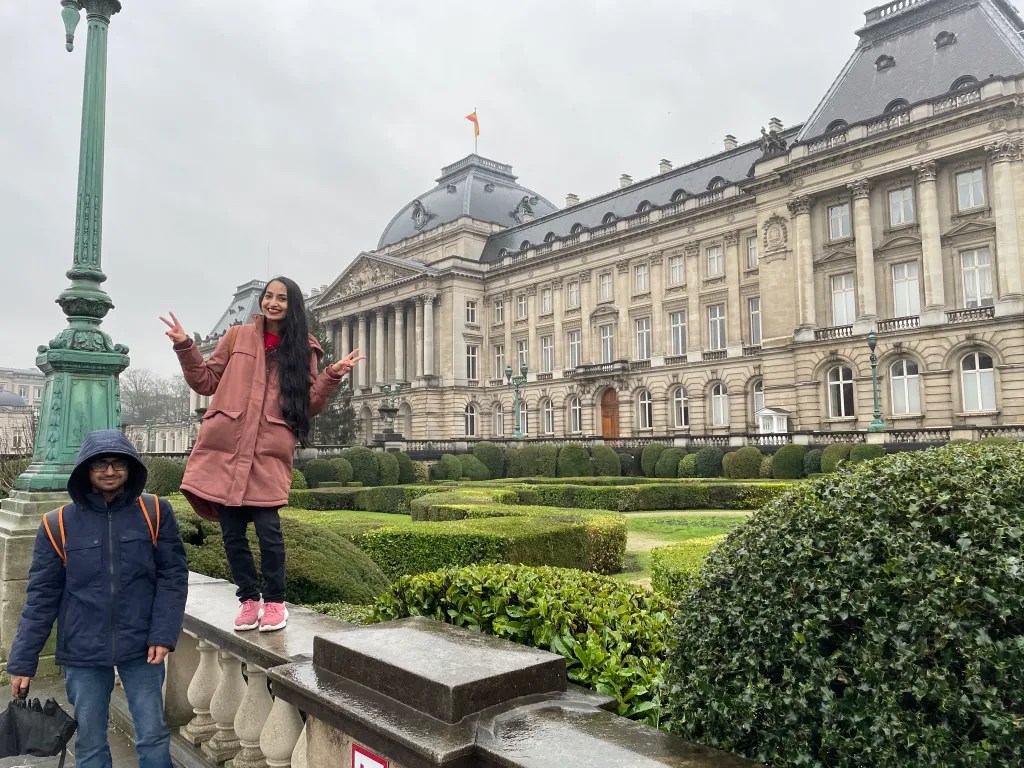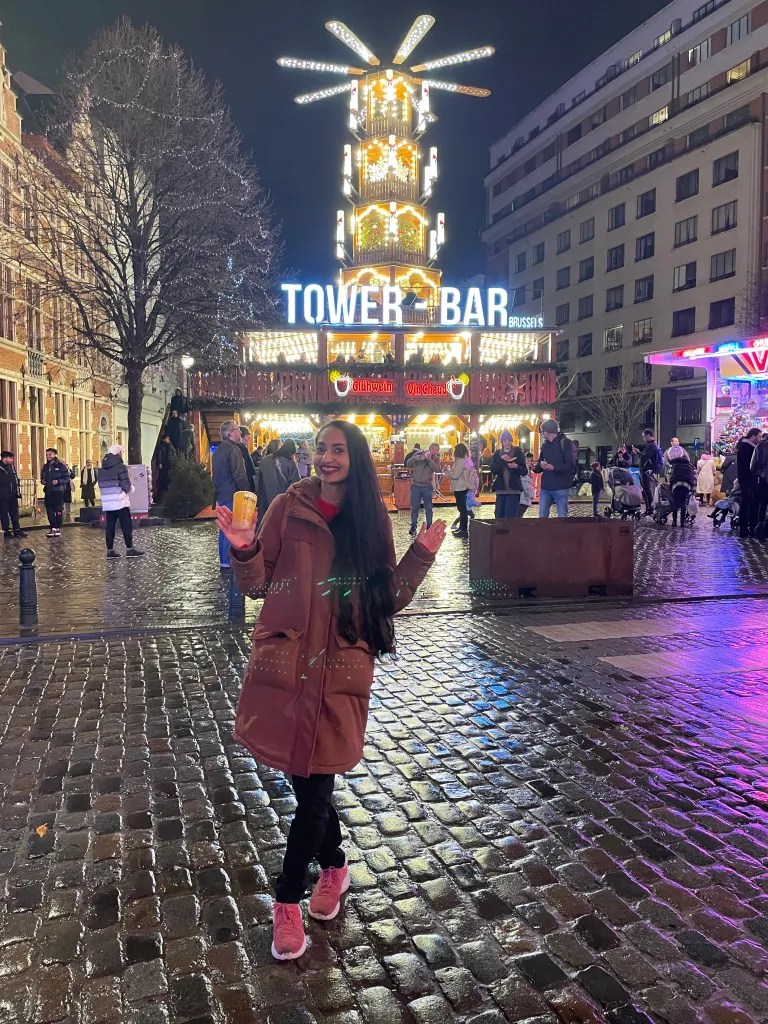Since Vibhi had come to spend his winter vacation at our place, we decided to take a day trip to Brussels for Christmas, as it is quite famous in Europe for its Christmas Market.

Day 1 – 25 December 2022
We reached Brussels at around 12 p.m. and kept our luggage in the locker room of our hostel. It was raining heavily, so we searched for an indoor place to visit.
We walked to Galeries Royales Saint Hubert, which is an ensemble of three glazed shopping arcades in central Brussels. It consists of the Galerie du Roi or Koningsgalerij (“King’s Gallery”), the Galerie de la Reine or Koninginnegalerij (“Queen’s Gallery”), and the Galerie des Princes or Prinsengalerij (“Princes’ Gallery”). The galleries were designed and built by the architect Jean-Pierre Cluysenaar between 1846 and 1847. We walked across the shopping arcade, admiring the shops and the building. When we reached the other side, it was still raining heavily, so we decided to have some waffles to pass the time. We went to Gaufres & Waffles, which serves amazing waffles. I generally don’t like sweet things, but I really loved these waffles. The waffles were very light and crispy.




It was still raining, and I saw some people eating Belgian fries, so we decided to find a place and eat in a shed. On the way, we found Jeanneke Pis (Little Pissing Joan), which is a modern fountain sculpture in central Brussels. It was commissioned by Denis-Adrien Debouvrie in 1985 and erected in 1987 as a counterpoint to the city’s famous Manneken Pis. The 50-centimetre bronze statue depicts a little girl with short pigtails, squatting and urinating on a blue-grey limestone base.


We went to Fritland which is a fast food joint with outdoor seating, a street-facing service hatch, and traditional Belgian fries. I didn’t think the amount would be too much, so we ordered 2 Belgian Fries, but we could not finish the entire thing, so we had to pack it for later.

The Brussels Stock Exchange was across the street, but I couldn’t click a lot of pictures of the building as it was under renovation. The eclectic building mixes borrowings from the neo-Renaissance and Second Empire architectural styles. It is adorned with ornaments and sculptures by well-known artists such as the Jacquet brothers, the French sculptor Albert-Ernest Carrier-Belleuse, and his then-assistant, Auguste Rodin.

Next, we walked to the Grand Place, which is the central square of Brussels. It is surrounded by opulent Baroque guildhalls of the former Guilds of Brussels and two larger edifices: the city’s Flamboyant Town Hall and the neo-Gothic King’s House or Bread House building, which contains the Brussels City Museum. The square measures 68 by 110 meters and is entirely paved. It is also a centre of annual celebrations during the Christmas and New Year period, and a Christmas tree has been erected annually on the square since the mid-20th century. When we reached there, it was not raining as heavily as before. We saw the huge Christmas tree as well as the shed showing Jesus’ birth.












Then we went to Mont Des Arts (Hill/Mount of the Arts), which is an urban complex and historic site in central Brussels, including the Royal Library of Belgium (KBR), the National Archives of Belgium, the Square—Brussels Meeting Centre, and a public garden. The Mont des Arts offers one of Brussels’ finest views. From the elevated vantage point, the famous tower of Brussels’ Town Hall on the Grand Place is clearly visible.







Palais Royal was nearby, so we went there next. It is the official palace of the King and Queen of Belgium in the center of the nation’s capital, Brussels. However, it is not used as a royal residence, as the king and his family live in the Royal Palace of Laeken in northern Brussels. By the time we reached there, it was raining heavily again. We got soaked while clicking pictures there.





Then we walked back to Grand Place, and on the way, we spotted a Tintin Mural. It was created in 1929 by Georges Remi, also known by his pen name Hergé. The adventurous reporter Tintin and his famed quiff hairstyle are without a doubt Belgium’s most emblematic figures. This particular mural represents a drawing from the album The Calculus Affair, published in 1956.



Finally, we reached Manneken Pis (Little Pissing Man), which is a landmark 55.5 cm bronze fountain sculpture in central Brussels, Belgium, depicting a puer mingens—a naked little boy urinating into the fountain’s basin. Though its existence is attested as early as the 15th century, it was designed in its current form by the Brabantine sculptor Jérôme Duquesnoy the Elder and put in place in 1618 or 1619. Due to its self-derisive nature, it is also an example of belgitude as well as of the folk humour popular in Brussels. The figure is regularly dressed up, and its wardrobe consists of around 1,000 different costumes. It has also been gifted with native country costumes from around the world, which are on display in a small museum nearby. We saw it dressed up in a Santa costume.




Our last stop was the Cathedral of St. Michael and St. Gudula, which is a mediaeval Roman Catholic cathedral in central Brussels. It is dedicated to Saint Michael and Saint Gudula, the patron saints of the city of Brussels, and is considered one of the finest examples of Brabantine Gothic architecture. The construction of the Romanesque church, which replaced an older chapel, began in the 11th century. Although its interior underwent numerous alterations in the years that followed, it was largely finished in its current Gothic shape by the 16th century. The structure has late-Gothic and Baroque chapels, and it was restored in the 19th century, which is when some of the neo-Gothic ornamental features, such as the stained glass windows in the aisles, were added. St. Gudula is notable for its musical features as well, particularly for its two pipe organs and its enormous church bells. The complex was designated a historic monument in 1936. We saw some cultural exhibitions going on where they had created Jesus’s birth scene as it is represented in different countries around the world.














After our visit to some of the important landmarks in Brussels, we decided to go back to our hostel and rest for a while before heading out again.
On the way back to our hostel, we found a map near the Grand Place Christmas Tree showing all the locations of Winter Wonders and Christmas markets. Winter Wonders takes place before and during the Christmas holidays in Brussels’ Grand Place and city centre. Winter Wonders includes a Christmas market with more than 200 chalets, a Ferris wheel, merry-go-rounds, an ice rink for skating, a large Christmas tree, a sound and light show at Grand Place, cultural activities, etc. So after our rest, we visited all the Christmas markets and attractions marked on the map.






















Finally, we had dinner at L’Express Rue Des which was a Lebanese restaurant. We ordered chicken shawarma and wine.



This was my first experience of a Christmas market in Europe, and I loved it. It reminded me a bit of our Durga Puja celebrations across the city with lights and fairs. Although it rained the whole time, I enjoyed the beautiful city!
Christmas is beautiful I’m glad vibhi was with you .you explore the city properly . I have been to Brussels but very briefly. I like your photo with Rishi in Front of Christmas tree.
Loved it.